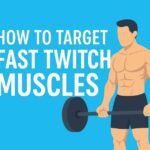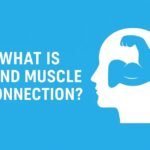Mind Muscle Connection: Lifting With Focus, Control, and Better Muscle Activation
Mind muscle connection is the ability to consciously contract a muscle during an exercise and feel it doing the work. It’s the skill of directing your attention to the muscle you want to train so the right fibers fire at the right time. Lifters often talk about “feeling the muscle work,” and this is exactly what they mean. You’re not just moving weight from point A to point B. You’re creating tension where it matters.
Take a simple bicep curl. Without awareness, most of the work shifts to the shoulders and forearms. The elbow swings, momentum takes over, and you barely feel the biceps. Now imagine curling with intention. You keep your elbows fixed. You lower the weight slowly. You think about shortening the biceps as the weight comes up and stretching them as it goes down. The movement looks the same from outside, but inside it feels completely different.
There’s real science behind it. When you focus on a muscle, more neural signals reach that area. Your brain recruits more motor units and improves the quality of the contraction. Studies using EMG (electromyography) show higher activation in targeted muscles when lifters use internal focus.

Beginners struggle because their bodies haven’t built strong movement patterns. The wrong muscles often take over. Advanced lifters rely on mind muscle connection intentionally because it helps them hit specific fibers, create more tension, and make every rep count. There’s a difference between lifting weight and lifting with tension, and the second one builds better muscle development over time.
Why Mind Muscle Connection Matters More Than You Think
Mind muscle connection matters because it drives better hypertrophy. When you train with internal focus, you put tension exactly where you want it. Hypertrophy is a response to targeted stress. If the right muscle isn’t working hard, it won’t grow no matter how much weight you move.
Many lifters have muscles that never grow because they can’t activate them properly. It’s common in rear delts, upper chest, glutes, and lats. You can do the right exercises and still get poor results if your focus is off. MMC (Mind Muscle Connection) solves this by improving recruitment and helping stubborn areas finally respond.
Tension, stretch, and control are the keys to muscle growth. MMC enhances all three. When you concentrate on a muscle, you slow down the rep naturally. You feel the stretch better. You control the squeeze. This creates micro-stress that leads to better adaptations.
It also helps you train safer. Better control reduces joint stress, stabilizes the spine and shoulders, and eliminates unnecessary swinging. Beginners often rely on momentum or compensating muscles because they don’t know how to direct tension. MMC teaches good habits early.
Even experienced lifters benefit. Pros use it to shape areas that need extra attention and get more from moderate weights. Heavy lifting is important, but MMC ensures those heavy reps hit the right fibers. You get a stronger pump, more metabolic stress, and deeper contractions that lead to long-term gains.
The Science Behind Mind Muscle Connection
Mind muscle connection is tied to how the nervous system communicates with your muscles. When you decide to flex a muscle, the brain sends electrical signals down motor neurons. These neurons activate motor units, which are clusters of muscle fibers controlled by one nerve. The more intense the signal, the more fibers you recruit.
Your attention strengthens the signal. When you think about a muscle, the brain increases neural drive to that area. This raises recruitment levels, increases firing frequency, and sharpens coordination between fibers. That’s why MMC creates stronger contractions even with the same weight.
Slow reps also play a big role. When you take your time on the eccentric phase, you increase the duration of mechanical tension. Slow eccentrics force the nervous system to keep fibers under control. This improves activation and teaches better movement patterns.
Stretch-mediated hypertrophy is another piece. Muscles grow more when you create tension in the stretched position. Internal focus helps you maintain stretch tension instead of bouncing through the bottom.
Isolation lifts make MMC easier because they limit the involvement of other muscles. Compounds rely more on external focus because the movement requires coordination of multiple joints. That’s why most lifters feel MMC strongest in curls, flyes, raises, and leg extensions compared to squats or deadlifts.
6 Benefits of Developing a Strong Mind Muscle Connection
1) Better Muscle Activation
Many people experience under-activation in specific muscles. This shows up as lagging areas like rear delts, upper chest, hamstrings, or glutes. When these muscles don’t activate properly, other muscles take over. MMC fixes this by helping you direct tension and ensure the right fibers fire at the right moment.
2) Improved Form and Stability
MMC forces you to slow down and control the weight. This reduces swinging, improves joint alignment, and teaches you to move through full range. Better control improves long-term strength and reduces wear on joints. Your reps become smoother and more intentional.
3) More Growth From the Same Weight
Tension triggers hypertrophy more than load alone. When you train with a strong MMC, even moderate weight becomes challenging. You can build impressive muscle size using controlled reps without constantly chasing heavier weight.
4) Better Stretch and Squeeze
A strong MMC improves your ability to feel the stretch at the bottom and the squeeze at the top. Stretch tension creates micro-tears that trigger growth. Squeeze tension increases metabolic stress and boosts pump. Both are essential for hypertrophy.
5) Injury Prevention
Training with control reduces jerky movements. Proper activation reduces stress on joints because helper muscles stop compensating. This lowers injury risk, especially in shoulders, lower back, and elbows.
6) Better Mindfulness During Workouts
Focusing on the muscle improves the quality of your sessions. You stay present, eliminate distractions, and feel more connected to the movement. This increases effort, consistency, and overall training satisfaction.
Internal Focus vs External Focus: When to Use Each
Internal Focus
Internal focus means directing attention to the muscle. It’s best for hypertrophy and for isolation exercises where the goal is to fatigue one area. It helps correct imbalances and sharpen technique.
External Focus
External focus means thinking about the movement rather than the muscle. This works well for strength and power because it lets you move explosively. Compounds like squats, deadlifts, and presses often feel better with external cues.
Combining Both
You don’t have to choose one. Use internal focus during warmup sets to activate the muscle. Use a mixed approach during moderate working sets. Switch to external focus for heavy sets so you can produce more force. Finish with internal focus during high-rep or burnout sets.
Exercises That Give the Best Mind Muscle Connection
Chest
Cable fly allows a deep stretch and strong squeeze. Dumbbell press helps you feel the pecs when elbows follow a natural arc. Machine chest press keeps tension constant and reduces shoulder involvement. Focus on stretching the chest, keeping elbows slightly tucked, and squeezing hard at the top.
Back
Lat pulldown works best when you drive elbows down instead of pulling with your hands. Seated row isolates mid-back when you keep your shoulders down and avoid using biceps. Straight-arm pulldown isolates lats well with controlled movement. Back MMC is tough for beginners, so slow reps help.
Shoulders
Lateral raises are perfect for MMC because they target the side delts directly. Use lighter weights and slow tempo. Rear delt fly helps target the often-neglected rear shoulder muscles. Machine shoulder raises offer constant tension.
Arms
For biceps, incline curls and concentration curls maximize stretch and isolation. For triceps, rope pushdowns and overhead extensions help create strong MMC because they target the long head deeply.
Glutes
Hip thrusts give strong peak contraction. Glute bridges let you feel the lockout. Kickbacks isolate the glute medius and create strong awareness. These exercises help people who struggle with quad or lower back dominance.
Legs
Leg extensions help you feel quad tension. Leg curls isolate hamstrings better than big compound lifts. Slow squats with controlled descent improve activation and reduce knee stress. Quads and hamstrings respond very well to MMC because they fatigue heavily under controlled tension.
5 Common Mistakes That Destroy Mind Muscle Connection
1) Lifting Too Heavy
Going too heavy shifts your focus from tension to simply moving the weight. You start compensating with other muscles. Your form breaks down and MMC disappears.
2) Rushing Reps
Fast reps reduce time under tension. You lose control, reduce stretch, and lower activation. Slow reps build more awareness.
3) Poor Setup
Bad angles, wrong machine settings, or poor bench height ruin alignment. A good setup locks your body in position so the target muscle does the work.
4) Holding Your Breath
Breath control improves awareness. Holding your breath increases tension in the wrong areas and reduces smooth movement.
5) Not Locking Shoulders or Hips
Stability improves the signal. A loose core or shifting hips reduces muscle activation and makes reps inconsistent.
6 Techniques to Improve Mind Muscle Connection
1) Pre-Activation
Use bands or light weights to get blood into the muscle before your main sets. This warms the neural pathways and improves recruitment.
2) Slow Eccentrics
Lowering the weight for 3–4 seconds increases tension and recruits more fibers. This builds strong contraction patterns.
3) Paused Reps
Pausing at the stretch or squeeze improves control. Stretch pauses increase lengthened tension. Top pauses improve peak contraction.
4) Touch Tension Method
Lightly tapping or touching the muscle improves awareness. Many coaches use this technique to help athletes feel the correct area working.
5) Visualization
Visualize the movement before performing it. Many bodybuilders rehearse the rep in their mind to strengthen control.
6) Mechanical Drop Sets
Switch between variations without resting. Start with the hardest version and move to easier ones. This burns the muscle deeply and improves focus.
How Beginners Can Build Mind Muscle Connection
Beginners should start with lighter weights so they can control each rep. Slow tempo helps teach awareness. Machines provide fixed paths that make it easier to isolate muscles. Single-joint movements like curls, extensions, and raises help beginners learn what each muscle feels like. High-rep sets are great for beginners because they give more time under tension and create better pump.
How Advanced Lifters Should Use Mind Muscle Connection
Advanced lifters should combine MMC with progressive overload. Use internal focus during moderate-load hypertrophy sets. Use external focus during heavy strength sets. MMC shines in stubborn body parts and finishing movements. Even with heavy weight, pros keep tension where they want it. Advanced lifters can mix both approaches depending on training block and goals.
Signs Your Mind Muscle Connection Is Improving
You’ll notice stronger pump, quicker activation in warmup sets, better focus, less joint pain, and smoother reps. You won’t need heavy weight to feel tension. You’ll feel soreness in the exact muscle you trained, not nearby areas. Your training becomes more efficient.
Sample Workout Built Around Mind Muscle Connection
Full Day Routine
- Cable fly – 3 sets of 15–20, slow tempo
- Dumbbell press – 3 sets of 10–12
- Lat pulldown – 3 sets of 12–15
- Seated row – 3 sets of 10–12
- Lateral raises – 3 sets of 15–20
- Rear delt fly – 3 sets of 15
- Leg extension – 3 sets of 15–20
- Leg curl – 3 sets of 12–15
- Hip thrust – 3 sets of 10–12
Focus on slow eccentrics, pause at stretch, and squeeze at top.
How to Use It
Warm up with light activation sets. Use internal focus on isolation exercises. Shift to mixed focus during mid-range sets. Finish with high reps to reinforce activation.
Final Thoughts
Mind muscle connection is a skill every lifter should develop. It improves activation, increases growth, and reduces injury risk. It helps beginners learn proper movement and helps advanced lifters target stubborn muscles. It lets you get more from moderate weight and train with better control. When you combine mind muscle connection with good form, consistency, and progressive overload, you build muscle more effectively and train with more purpose.






